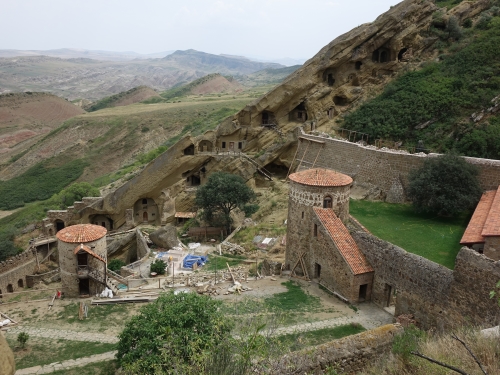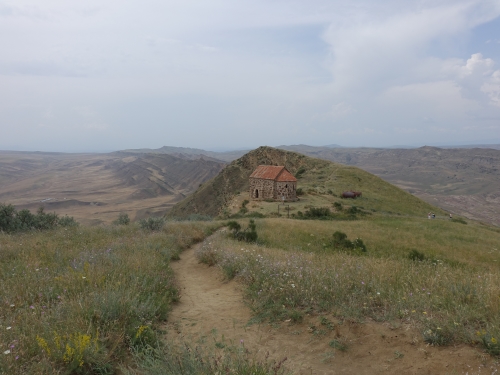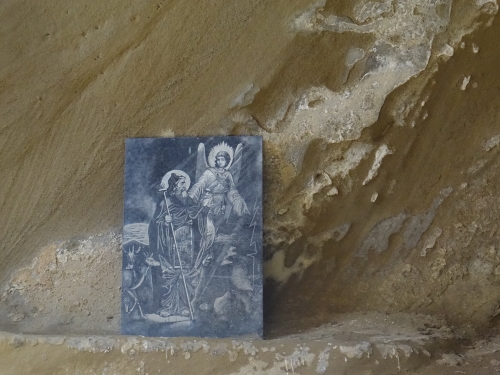Blog TWHS Visits
David Gareji Monasteries
The David Gareji Monasteries and Hermitage are located in the far southeast of Georgia, right on the border with Azerbaijan. There is no public transport that goes all the way there, but every day at 11 o'clock a special shuttle bus (The Gareji Line) departs from the Pushkin statue in the center of Tbilisi. This will take you to the monastery for 25 lari (8 EUR), and will return 3 hours after arrival. You cannot reserve this bus and I was afraid that it would be very busy on a Saturday when I had planned to visit. It was, but in that case they just send another bus.

The drive there takes 2.5 hours, with the landscape becoming more and more beautiful along the way. At the end you’re in a vast steppe with rolling green hills and many birds. The monasteries are built against a cliff, and that gives them their special charm. In the rocks there are hundreds of natural and carved caves: they were used as monks cells, chapels and churches. The site consists of two parts: the Lavra monastery at the entrance, where a dozen or so monks live and they are busy renovating at the moment. And the Udabno monastery, at the top of the rocks.
The shuttle bus is ‘transport only’, so for finding the sights we’re on our own. I started to follow an arrow marked 'Udabno' that points up from behind the monastery shop. This turned out to be a steep climb on a narrow sandy path with boulders. I gave up on that after 10 minutes. I noticed another path that runs halfway up the cliff and rises more slowly. According to the schematic map that I received from the bus company you have to be able to go up via this route as well, the paths form a loop.

Walking here is a lot easier, and soon I passed a cave carved into the rocks - with a staircase cut from the rock so you can get to the entrance. Unfortunately the cave is closed by a door. It took me an hour to get to the mountain ridge. At a small chapel there I encountered a lone Georgian soldier, guarding the border. In determining the modern boundaries between Georgia and Azerbaijan, they only put a straight line on a map. That worked out unfortunate for the David Gareji monasteries: the lower half (Lavra) now lies in Georgia and the upper one (Udabno) in Azerbaijan. Walking on the mountain ridge, you're exactly on the border. The Azerbaijani border post is a long way away though and a visit to both sides of the monastery is possible without border control.
After walking for 1.5 hours I still had not reached or discovered the upper monastery. And I wasn't the only one, I frequently met other tourists coming out of a cave or chapel in the hope of finding the famous murals. My suspicion is that it is located on a lower ridge on the Azerbaijan side: there you can see another series of caves, and I saw also people walking there. However, I did not want to descend anymore because you'll have to climb the same part back up again! To complete the hike I still needed to go down the steep part, back to the parking lot and the lower monastery.

After finally having arrived unharmed at the bottom again, I went to see the Lavra monastery. It looked closed because of the renovation, but you can still visit the courtyard and the church. The latter appears rather new on the inside, but has been reported here since the 6th century. It contains the tomb of David Gareji, the founder of the monasteries who came along with 12 other monks from the Middle East. The courtyard has one cave where you can look inside, the others are behind closed doors. This apparently was the cell in which David lived. Unfortunately the picturesque row of cells above it is always closed to visitors.
P.S.: In the Lonely Planet travel guide you will find good instructions to get to the Udabno monastery. You must indeed follow the steep path to the right behind the watchtower until you reach a half-rusted railing. Below that, the path runs to the left to a ledge below, on which are the caves that form this part of the monastery. You can also get there via the long route to the left which I took (and which is less steep), but then you need - if you are as bad a climber as I am - up to 3 hours for the entire tour.
Els - 23 June 2018